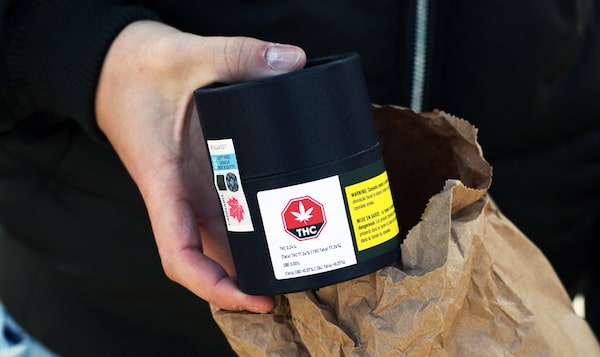
A customer shows the marijuana he bought in a cannabis store in Quebec City in 2018. Health Canada says it is reviewing complaints about inaccurate labels on cannabis products, and in July it launched a data collection program that involves comparing product results to potency claims.ALICE CHICHE/AFP/Getty Images
Your pot may not be as strong as you think it is.
Cannabis producers and testing laboratories say that many labels on legal dried cannabis misrepresent the amount of THC and CBD actually contained in the dried flower, and often overstate both.
Studies by two labs and a cannabis producer show that label claims for dozens of products do not match the reality of the potency stated, and some contain 20 per cent less THC than the amount specified. The Globe and Mail has not independently verified the results of these studies.
“There are cannabis companies in the top 10 that are absolutely inflating their flower values,” said Borna Zlamalik, senior vice-president of innovation and research and development at Moncton-based producer OrganiGram Holdings Inc. OGI-T. “I think there are some companies that have maliciously narrowed down their sample procedures to get the best flower.”
Producers and laboratories say this undermines part of the point of legalization – to create trust and confidence among consumers – and could lead to negative health outcomes for users.
Some critics attribute the disparities to a lack of standardized testing methods and government oversight, saying producers are cherry-picking and processing samples in ways that are not representative of entire batches of pot and the THC contained in the end product. Other allege that some cannabis testing firms use fraudulent techniques to produce inflated THC results.
Health Canada says it is reviewing complaints about inaccurate labels, and in July it launched a data collection program that involves comparing product results to potency claims.
“If the program identifies deficiencies with legal products they analyze, appropriate compliance and enforcement actions will be taken to mitigate health and safety risks, as necessary,” Health Canada spokesperson Tammy Jarbeau said.
How safe is our cannabis? Nearly five years after legalization, we still don't know
Concerns about potency spiking are not new, but the issue has worsened over the past year as producers and laboratories have attempted to win business in an oversupplied market, Mr. Zlamalik said.
Price and potency have become two of the few markers customers have to differentiate between products. To cater to buyers, the average potency of products on the market has crept up over time. Mr. Zlamalik said Organigram is missing out on revenue every quarter as consumers increasingly opt for competitors’ products with higher advertised potencies.
In a statement, Organigram chief executive officer Beena Goldenberg said the practice “of inflating the stated THC potency on flower products” through selected sampling and testing practices is “increasingly widespread.”
One Kelowna, B.C.-based testing laboratory, Supra Research and Development, tested 46 dried flower products purchased off the shelf, and said none met the THC label point. The majority were more than 20 per cent below it.
“With normal variants, you would expect some above and some below,” said Rob O’Brien, Supra’s CEO. “There is an issue with mislabelling cannabis in a manner that increases profit. But that isn’t because the labs are unable to test it.”
Mr. O’Brien said his lab has lost business to labs he believes are producing inflated THC values, and has laid off some staff as a result.
In a similar test of 35 flower products, High North Labs, a Vaughan, Ont.-based cannabis lab, said it found that no products met the stated potency, with the majority at least 5 per cent under the stated amount. In the most extreme case, a product labelled at 38 per cent tested at only 19 per cent, according to the company.
The company’s CEO, John Slaughter, said that of a total of 350,000 samples tested by his lab, only a handful have returned at more than 32-per-cent potency. That the provincial government’s Ontario Cannabis Store sells 135 dried flower products claiming to rate above that number is “proof of fraud,” Mr. Slaughter claims.
Gord Nichol, president of family-run Saskatchewan producer North 40 Cannabis, said he independently tested 33 competing products, and found the results to be “abysmal,” with only around a fifth meeting “acceptable” variances.
Miguel Martin, CEO of Edmonton-based Aurora Cannabis Inc., agreed that the lack of national sampling protocols has resulted in “variability” in interpretation of the accepted testing methodology.
“I hope the industry rallies around a standard,” Mr. Martin said. “I think that would be the best thing for all of us.”
Health Canada told The Globe that is reviewing complaints made about inaccurate potency labels, and the information received will be used to conduct further compliance monitoring this fiscal year.
The Cannabis Data Gathering Program, launched in July, will pro-actively collect information on the legal and illicit cannabis markets in Canada, including purchasing and testing retail products for THC and CBD content. Ms. Jarbeau said the program will compare government laboratory results with the labels.
Health Canada does not review or preapprove packages and labels of cannabis products. However, Canada’s cannabis regulations require that every lot or batch of cannabis be tested for, among other things, the concentration of THC and CBD, and that testing must be conducted on the final form of the cannabis.
Unlike with edible cannabis, cannabis extracts and cannabis topicals, the regulations do not set out variability limits for the amount of THC or CBD that can be found in dried cannabis versus the amount indicated on the label. Health Canada says this is because the amount of THC in dried flower can vary widely.
Health Canada said it has taken initial steps to research what an appropriate THC variability limit in dried cannabis could be.
In the European Union, the variability limit is 10 per cent, and 20 per cent in Australia. Germany tests all its imported medical cannabis to ensure their results fall within 15 per cent of the stated potency. If it does not fall within these limits, it cannot be sold.
So far in 2023, Health Canada conducted 28 inspections of high-potency cannabis, in which it tested 56 cannabis products. While not all products contained the exact amount of THC stated on the label, there were no serious risks to public health identified and the investigation was rated as compliant under the Cannabis Act, Ms. Jarbeau said.
“The department is currently working with licence holders to address inspection observations and to ensure that the THC content value displayed on the label is representative of the cannabis product,” Ms. Jarbeau said.
In the United States, claims about potency inflation have been confirmed by academic research. A University of Northern Colorado study published in April found that labels on 80 per cent of cannabis products overstated the THC potency, with the majority misrepresenting strength by at least 15 per cent. The study analyzed 23 samples of dried flower, purchased from 10 dispensaries across Colorado.
Following complaints about potency spiking, Michigan’s cannabis regulator automatically audits test results of more than 28-per-cent total THC, and the State of Washington has shut down labs for producing higher-than-normal results, following alerts from an independent watchdog.
Editor’s note: An earlier version of this story incorrectly stated Health Canada tested 58 products as part of an inspection of cannabis potency. This version has been corrected to 56 products.
 Irene Galea
Irene Galea Jameson Berkow
Jameson Berkow